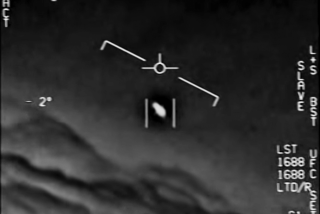Light Years: AN INVESTIGATION INTO THE EXTRATERRESTRIAL EXPERIENCES OF EDUARD MEIER by Gary Kinder (Atlantic Monthly: $18.95; 266 pp.)
- Share via
“Light Years” is the story of Swiss farmer Eduard (Billy) Meier who has several hundred beautiful color photos and a few home movies of what he claims are crafts from the Pleiades, some 500 light-years away. Despite the vast distance, Meier says it takes his friends only several hours to make the trip. Meier says his extraterrestrial friends often take him aboard their craft, which can travel backward or forward in time.
This, Meier claims, has enabled him to speak with Jesus, to photograph the eye of God, and to photograph the futuristic ruins of San Francisco after an earthquake. Nearly seven years ago, MUFON, the nation’s largest group of UFO believers, published a report which characterized Meier’s claims and his flying-saucer photos as “The Most Infamous Hoax in UFOlogy.” Rarely does a pro-UFO group publicly admit a hoax, let alone use such harsh criticism.
Gary Kinder, who authored this book, said he was warned about the Meier case by almost every UFOlogist he interviewed during his early research several years ago. But after three visits to Switzerland and the 13 weeks he spent there “investigating” Meier’s tales, it was the beautiful color photos of saucer-shaped objects that Kinder found so convincing. Although one Meier UFO photo also shows a Swiss fighter aircraft, its pilot seemingly never noticed the nearby UFO.
Not until Page 225 of the 266-page book does Kinder inform his readers that Meier admitted carving a small model flying saucer which he used for some of his photos. The admission came after less-convincing photos Meier thought had been destroyed found their way into the possession of a one-time admirer via Meier’s disgruntled wife. But just because some of Meier’s UFO photos were hoaxes didn’t prove that all of them were of the same genre, at least to Kinder.
When one of Meier’s (former) admirers chanced to recognize that the picture of a devastated San Francisco was identical to an artist’s painting of what San Francisco might look like after an earthquake, which had been published in GEO Magazine, Meier had a ready explanation: His Pleiadian friends had “simply placed in the artist’s mind an accurate picture” of how they knew San Francisco would look after it was destroyed.
Kinder said he finds it hard to accept some of Meier’s “outlandish claims.” But, again, just because Meier tells some spurious tales, that doesn’t prove that all of his tales are concocted, at least in Kinder’s view. It is not clear whether the author accepts reports of Meier’s ability to de-materialize himself and later reappear. Or Meier’s claim that the Pleiadians gave him a “laser gun” that he never shows anyone but whose existence is evidenced by burn-marks on the brush in the woods.
But what of Meier’s handful of 8mm home movies of the saucers? While hoax photographs of UFOs are remarkably easy to make, movies are much more difficult, especially for Meier, who lost his lower left arm in an accident nearly 20 years ago. Kinder doubts that Meier’s many friends include a film-making accomplice, but the author does not report any rigorous effort to unearth one.
The author quotes a film maker experienced in making “Star Trek”-type movies as saying it would cost many thousands of dollars and a large crew to re-create Meier’s UFO movies--clearly beyond the Swiss farmer’s modest means.
But a more skeptical analyst, Kinder reports, observed that when one moving UFO tried to stop, it would swing back and forth like a pendulum, as if it were suspended by a thin thread from a fishing pole.
(Recently, I had my first chance to see one of Meier’s UFO movies when Kinder and I appeared together on a TV talk show in Seattle. Kinder, commenting as the film was shown, pointed out automobiles in the distance driving right past the UFO. A perceptive member of the studio audience pointed out that if the object were a giant craft, it would necessarily be near the automobiles and would certainly have attracted the attention of many motorists, at least some of whom would have slowed or stopped to watch. Yet none did.)
About one-fifth the way through the book, seeking to establish Meier’s forthrightness, Kinder wrote that he “even told me of his time in jail.” But the reader learns nothing more about Meier’s prison record until Page 231 when Kinder quotes another source as saying that Meier “was jailed for thievery as a teen-ager.”
Only at the end of the book, in an author’s note, does the reader learn that Kinder himself has twice knowingly resorted to falsehood in his book, without any obvious motivation to do so. On Pages 177 and 222, Kinder described interviews that he says were conducted by others whom he identifies. But in the author’s note, he admits that he himself conducted both interviews, and the persons he earlier mentioned were not even present.
Kinder’s first book, “Victim: The Other Side of Murder,” won praise from many reviewers, but this, his second, can be praised only for demonstrating the validity of Francis Bacon’s observation: “A credulous man is a deceiver.” In the case of “Light Years,” Kinder appears also to be the principal victim.
More to Read
Sign up for Essential California
The most important California stories and recommendations in your inbox every morning.
You may occasionally receive promotional content from the Los Angeles Times.













